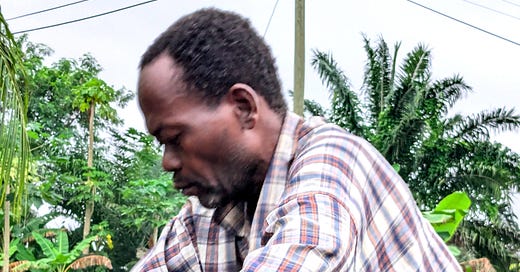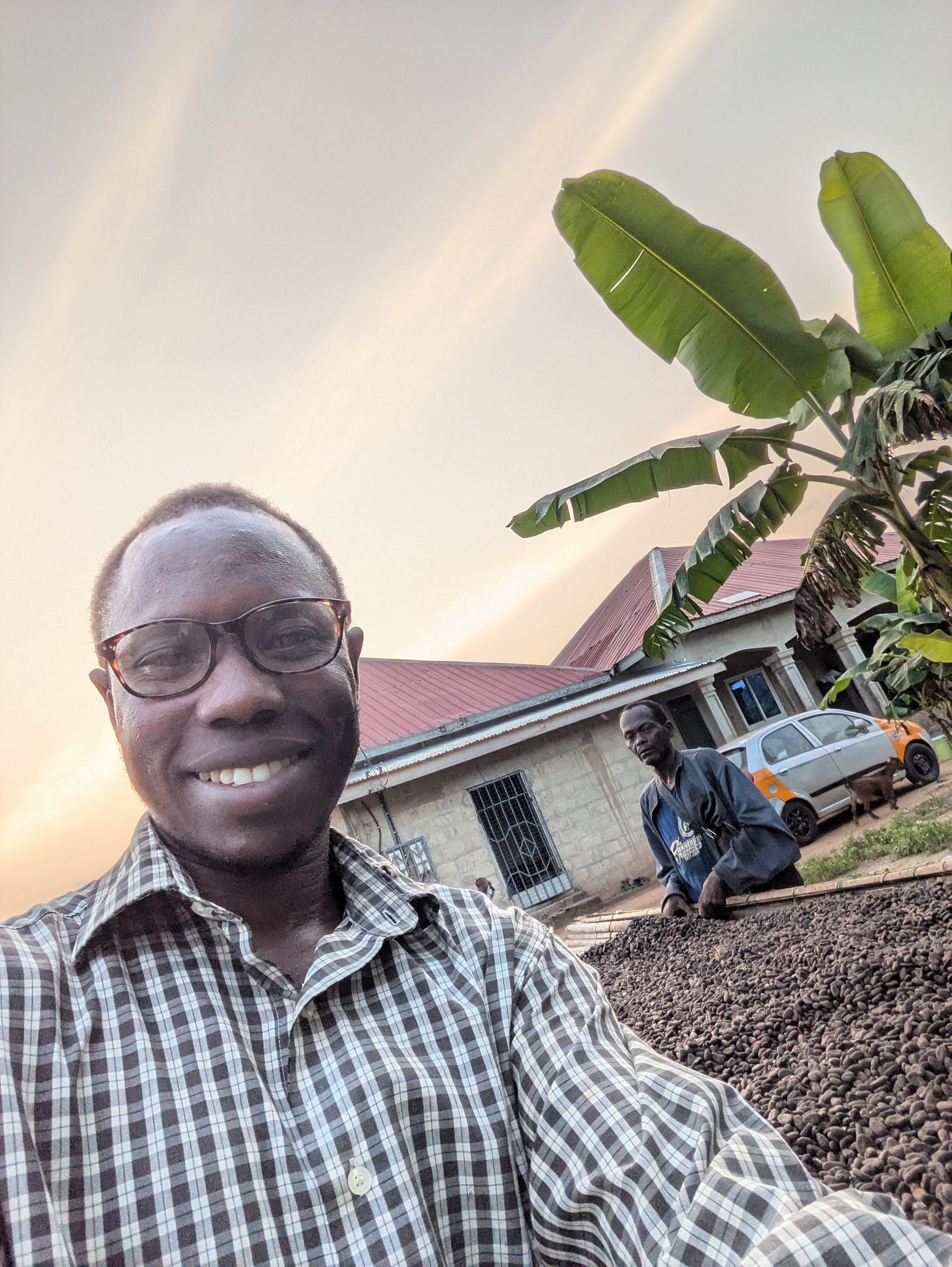Why do chocolate lovers know so little about the people who produce cocoa?
A flaw in the cocoa supply chain
In my last letter, I highlighted the following thought:
Chocolate lovers are curious about the cocoa supply chain. They want to hear stories about the people who grow cocoa, where they live, their culture, and how they grow this crop for chocolate to happen.
The question then is, why have people enjoyed chocolate for centuries and yet know so little about the stories of the people and cultures at its root?
I think a major reason for this disconnect is that the supply chain was made to deliver goods.
Not stories.
To explain my point, let me show a tough moment in the life of Mr. Acheampong - a Ghanaian cocoa farmer.
When I took this photo, it had been almost two weeks since the 70-year-old poured this batch of fermented cocoa onto his raffia mat to dry. And on each of those days, he was held hostage.
How?
Four to six days of strong sunshine would normally be enough to dry the beans. But this was June-July, one of the rainiest periods in Ghana’s forest zones when the sun always hid behind dark clouds, peeking out briefly before giving way to rain.
Sometimes, rain and sunshine were like two toddlers fighting over a toy. The sun would show up, and the farmer would rush to uncover the beans and spread them across the mat. Just as he was almost done, it would start drizzling. So, he’d cover them again. Five minutes later? Sunshine. Seven minutes after that? More rain.
“Ah, isn’t this annoying?” he asked me as I stood across the mat watching him cleaning the mold off some of the cocoa beans.
Of course it was. Technically, lack of proper sunshine delayed the drying process and disrupted the chemical reactions meant to produce the fruity chocolate notes Ghana’s cocoa is famous for. But, worse still for the farmer, the beans risked losing weight and quality. Some were already moldy. Others must be thrown away. That means less money for him.
And yet, the real frustration isn’t only about quality or income:
“I can’t even go anywhere. The guy says he has finished pruning the cocoa trees, but I can’t go and inspect the work. I have yam seeds under my bed, but I’m not able to go and plant them. I can’t even go to town to sell my (herbal) medicine.”
Unfortunately for him, his wife had traveled to see her parents. And his children are all grown and living elsewhere. And so, in this unpredictable period when the cocoa needed more attention, he remained grounded.
So let me ask you, dear friend:
As a chocolate lover, wouldn’t you want to know more about Mr. Acheampong? Wouldn’t you love to learn how he handles a moment like this, standing between the rain and the sun, trying to make sure that your delicious chocolate is still possible?
I think you would. But here’s why you don’t:
When the cocoa finally dried, Mr. Acheampong carried it to the Licensed Buying Company. The Purchasing Officer examined it. Was it dry enough? Free from mold? Free of debris? When the beans passed the quality check, the officer weighed it and paid the farmer.
And just like that, the story was lost.
Mr. Acheampong walked home, relieved to finally have his money. His cocoa was bagged and sent on its journey through the supply chain. And by the time it became chocolate, no one knew that moment when the beans almost didn’t make it.
No one, except Mr. Acheampong himself. And I, Benjamin, who was there, watching as it all unfolded, and documenting it.
And now I’m sharing it here with you - not just to tell a story, but to make a point:
The cocoa supply chain, by its very design, moves cocoa. Not stories.
This, to me, is a flaw.
As a storyteller who wants the enjoyment of chocolate to gradually bridge the gap between consumers and cocoa-producing cultures, my vision is a new cocoa supply chain. One that not only prioritizes the safe movement of quality cocoa beans but also ensures the safe movement of the stories of the people behind the beans.
But how would this new supply chain play out? And why is it so important to me that chocolate lovers learn about cocoa producing regions? Also, how are people learning about cocoa farmers despite this supply chain flaw?
These are big questions we’ll explore together in future letters. But I’m curious. What are your thoughts on this thought?
📢PS/Announcement:
I’m working on a paid series of online storytelling events. Where Maximum Ten participants meet to hear stories of the amazing cocoa farmers and other actors in the cocoa supply chain. Ten participants per event means everyone gets to share their thoughts and ask questions.
I’ll return with more feedback. But if you’re curious to learn more, send me a message benjamin(at)africancocoastories.com.
Be safe.❤️
credit: Thanks to
, and James Cofie who read this draft.






This is such a special story - the first of many I hope, Benjamin.
The detail, and the "hostage-taking" reminded me of when I was a young girl tasked with watching the paddy dry on the mat outside our village home, shooing away the birds who would come for a free meal, keeping the cats from leaving their own tracks beside my grandmother's as she turned the rice over so it could all dry before being stored for the season.
I am tagging @sam knowlton, because tracking the story of the supply chain is a necessary part of resurrecting a love for the soil and everything it gives us.
…you know this or at least i hope you do but it is incredibly cool that you can and do share these stories…